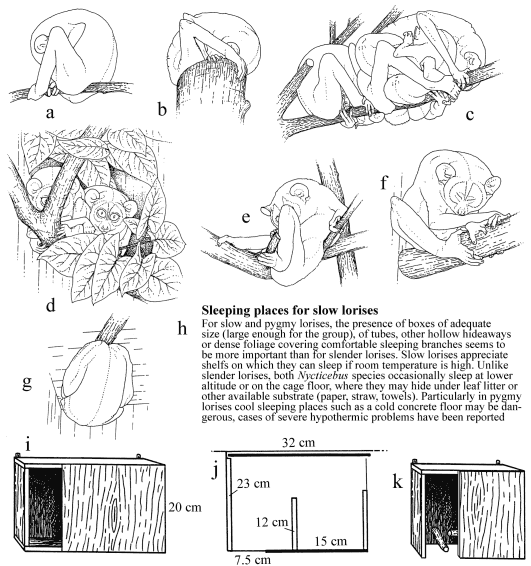
| Home |
|
|
|

Choice of sleeping places and meaning of different sleeping postures (compare with the figures showing signs of weakness and disease!)
a-c: Slender lorises usually sleep sitting on branches or horizontal surfaces in the upper part of their cage. Sleeping in the open is common in animals feeling safe. Sleeping places providing some cover and lateral support (d), however, are appreciated. Cover as shown in fig. d or sleeping boxes are particularly preferred by shy animals or in periods of environmental disturbance. Sleeping huddled together (c) is common. If animals formerly sleeping together suddenly chose distant sleeping places, social stress after quarreling may be a reason. Sleeping on branch forks in lying posture is sometimes shown by youngsters still used to sleep cradled on their motherīs legs (e), as an individual habit or in sick and old animals as a sign of weakness. When ambient temperatures are high, the animals often do not roll up tightly as usual, but in relaxed posture more adequate for emitting heat (f). Hanging under the ceiling of the cage during sleeping period (g) usually is a sign of environmental distress, it shows flight tendency upwards where the animals feel safest. The text under h mentions different needs in the Nycticebus species. Warm sleeping places are particularly important in N. pygmaeus, but old and sick slender lorises, too, may need a warm place for sleeping.
Fig.
i
and j show a sleeping box as used at Ruhr-University,
with a second
lateral exit added for escape in cases of quarreling (j:
interior seen
from above, with a small median wall providing additional
opportunity to
hide; the back wall can be removed for cleaning). The box might
be further
improved by branches inside as in the second proposed type of
sleeping
box (i); no preference test for different boxes has been
made so
far at Ruhr-University.
|
Slender
loris husbandry information
Preliminary
draft;
H. Schulze
|
Last
amendment: 17 January 1999
|